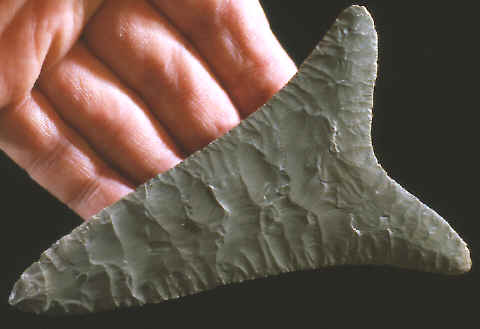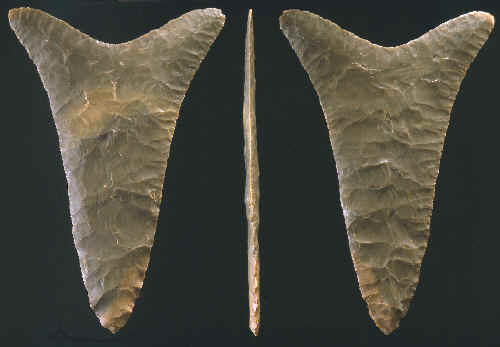|
FISH TAIL BIFACE
PREDYNASTIC
EGYPT

CAST
#N-4
EARLY
STYLE FISH TAIL BIFACE
PREDYNASTIC
EGYPT
ORIGINAL IS IN THE LEN & JANIE WEIDNER COLLECTION
By Michael Allen Hoffman
Fish Tail
bifaces are well known from Predynastic tombs and have occasionally been
uncovered in settlement sites at Hierakonpolis. They are shaped like
elongated triangles with deeply concave bases, are thin finely retouched
objects and many of the earlier specimens display minute
denticulation.
Originally thought to be
spear points, discovery of a hafted specimen showed that the concave end
faced outward while the pointed end was embedded in the handle. It is
now believed that Fish Tails were used in the religious rite of
symbolically opening the mouth of the dead just prior to burial so that
the deceased's soul could receive sustenance in the tomb. A Fifth
Dynasty papyrus (ca. 2400 B.C.) from Abusir refers to similar objects by
the Old Egyptian term "Peshish Kef."
This Fish Tail biface represents a product made by a highly skilled craftsman. It was made at a time when stone tool making in
Egypt had reached a golden age of flintknapping. This example has
a U shaped base and is probably an earlier style (A.J. Arkell 1975
p.46). It measures 4 1/2
inches (11.4cm) long, 2 15/16 inches (7.5cm) wide and 3/16 of an inch
(5mm) thick.

CLICK ON PICTURE FOR
LARGE TRIPLE IMAGE
PICTURE OF THE
ORIGINAL #N-4 FISH TAIL BIFACE
PREDYNASTIC
EGYPT
LEN & JANIE WIEDNER COLLECTION
CLICK
HERE FOR MORE FISH TAIL BIFACES
|

